Brush-tailed Rock-wallaby
Brush-tailed Rock-wallabyPetrogale penicillata | |
|---|---|
| Kingdom: | Animalia |
| Phylum: | Chordata |
| Class: | Mammalia |
| Subclass: | Marsupiala |
| Order: | Diprotodontia |
| Family: | Macropodidae |
| Status | |
| World: | not available |
| Australia: | Vulnerable (EPBC Act 1999) |
| Victoria: | Critically endangered (FFG Threatened List 2024) |
| FFG: | Listed; Action statement No. 19 |
| Species profiles | |
| Australia: | Atlas of Living Australia profile |
| EPBC Act: | SPRAT species profile |
| Victoria: | |
 | Zoos Victoria Figthing Extinction profile |
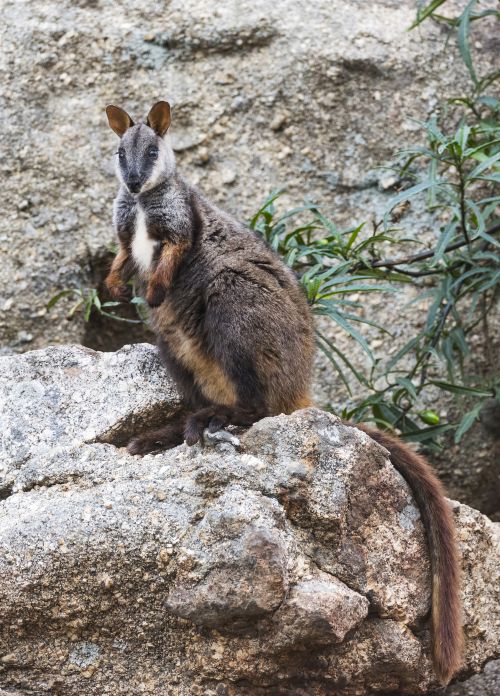
The Brush-tailed Rock-wallaby (Petrogale penicillata) is one of at least 16 species of Rock-wallaby Petrogale in Australia and is the only species of Rock-wallaby that occurs in Victoria. It is a small wallaby with a head and body length of about 450mm and a long black tail about 610mm that has a brushy end. Adults weigh up to 7.5 kg. They are mostly a dull grey- brown colour with rufous toning on the rump. Head and face markings include a black stripe, which runs from near the tip of the nose to the back of the head, and a light coloured cheek stripe (Maynes & Sharman 1983, Maxwell et al.1996).
Distribution
Three distinctive taxonomic groups of Petrogale penicillata are recognised from analysis of mitochondrial DNA,
- Northern (northeast New South Wales /southeast Queensland)
- Central (central NSW)
- Southern (Victoria), (DEECA 2023). In Victoria it is confined to the upper Snowy River in East Gippsland and to the Grampians in the South West region of Victoria.
The last known wild record at the Grampians was in 1999 when the last remaining female was trapped and integrated into the captive breeding program. The site was centred on a small area of about 10 ha at Red Rock, on the western edge of the northern Victoria Range, although evidence from scats indicate the Brush-tailed Rock-wallaby once occupied a much broader area. Surveys of potentially suitable habitat were carried out in 1986, which identified 59 sites where the Brush-tailed Rock-wallaby would have once been found, key areas for this species were the northern Victoria Range, the Mt Stapylton Range and the Cave of Ghosts area. Seven old sites were also identified in the Black Range. No records were found in the Mt Difficult Range, whilst the Mt William Range, the eastern escarpment of Victoria Range and the Serra Range were considered unsuitable habitat. (Lobert & Waters 1988).
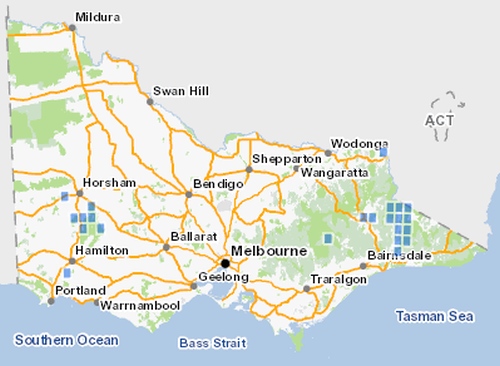
Ecology & Habitat
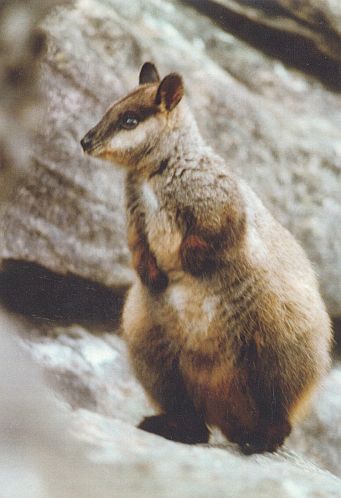
Photo taken by Raz Martin in the Grampians 1999
The Brush-tailed Rock-wallaby inhabits extensive rock outcrops with complex rocky features such as boulder heaps, deep fissures, caves, ledges and overhangs. Preferred habitat in the Grampians comprises north-east to westerly facing broken cliffs most often associated with areas of smooth rock and reddish-orange coloured rock which indicates a rock face sheltered from the rain. Their habitat can also incorporate sites that provide moisture in the form of seepage from rock crevices. They are known to feed on grass, herbs, orchids, ferns, fruits and leaves from shrubs and trees (Lobert & Waters 1988, DEECA 2023, Menkhorst 1995)
Threats
In historical terms it is likely that during the latter part of the 1800s European settlers inflicted the greatest damage to populations in New South Wales and Victoria. Hunting was carried out primarily for skins and as a perceived pest control measure often in areas near settlement. There was also an active fur trade, for instance at least 144,000 skins were sold through the Sydney fur trade market in the 1890s (Lunney 1997). The impact of hunting in the Grampians and Black Range is unclear but there is reasonable evidence from old scats that remnant populations existed in the Mt Stapylton Ranges, Epacris Hills, Cave of Ghosts region, northern Victoria Range, Red Rock and northern Black Range up until the mid 1970s (Lobert & Waters 1988). An overall decline in the Grampians and Black Range populations is likely to have been the result of a combination of factors that started with European settlement, which included hunting and subsequently the introduction of predator and competitor species, altered fire regimes and isolation of remnant populations.
Threats to the success of a reintroduction program are elaborated in (Delaney et al. 2004) and are associated with:
Predator control of the Red Fox and Feral Cat which are agile hunters, being able to reach rocky habitats occupied by the Brush-tailed Rock-wallaby. Parasites transmitted by feral cats are also of concern. It is clear that introduced predators are a major problem in reintroduction efforts (see 2013 update).
Competition from other herbivores such as European Rabbit and Goat may reduce availability of food, particularly when environmental conditions are unfavourable such as drought or shortly after fire. Evidence of Goat droppings were found at 60% of sites previously occupied by the Brush-tailed Rock-wallaby in the Grampians (Lobert & Waters 1988).
Fragmentation of isolated populations and inbreeding may contribute to the extinction process of small, isolated populations.
Wildfire has the potential to burn remaining areas of vegetation required for feeding and force animals away because of food deprivation. Changes to floristic structure also require research by monitoring and adapting management to ensure suitable vegetation diversity and structure is available.
Actions
A number of innovative methods have been developed for monitoring this species. Research into methods for estimating population parameters such as population size, population structure and dispersal in P. penicillata colonies may be facilitated by individual identification via DNA profiling of faeces (Piggott et al. 2006). Researchers have also developed methods for monitoring dispersal through detecting and monitoring gene flow into populations (Eldridge 2001).
Maintaining captive breeding populations to support the re-introduction program is crucial for on-going recovery. Key captive breeding sites are Mt Rothwell (Vic), Tidbinbilla Nature Reserve (ACT). Adelaide Zoo - Waite Institute and Waterfall Springs (NSW) have also contributed to captive breeding in the past. It was originally proposed to re-introduce up to 16 Brush-tailed Rock-wallabies at pre determined sites in the Grampians during the Spring of 2007. However due to the impact of the extended drought and Mt Lubra bushfire which burnt much of the Grampians in January 2006, this date was postponed to Spring 2008. The initial release site was Moora Moora Creek with two back up sites identified in case the preferred site was not suitable. Assessments to gauge the status of habitat condition were conducted to assess the impact of the Grampians wildfire’s of January 2006. Between 2008 and 2012 the program has continued with on-going releases in the Grampians. Due to high mortality rates detected in 2013 the reintroduction program has been suspended pending a full review of recovery program objectives.
A Victorian recovery team manages the program with a Captive Management Team, East Gippsland Field Management Team and a Grampians Reintroduction Team.
Release of captive bred Brush-tailed Rock-wallaby in the Grampians in 2008 with temporary transmitter fitted to tail.
Conservation & Management
Specific actions for the conservation of the Brush-tailed Rock-wallaby
Grampians National Park
- Upgrade existing predator control program in preparation for reintroduction.
- Identify preferred translocation site in Grampians NP.
- Develop predator and competitor monitoring protocols for implementation at reintroduction sites pre- and post- release.
- Develop habitat monitoring protocols.
East Gippsland - Snowy River National Park
- Biannual trapping and strategic camera surveillance is undertaken at four main colonies.
- Control of foxes and wild dogs is considered a major threat which requires on-going and frequent predator control around each of the colonies .
- Research involving scat analysis will be used to describe the seasonal diet of rock-wallabies and other sympatric herbivores.
- Research is being conducted to determine the success of dispersal movements and the causes of mortality of dispersing animals.
- Research is being conducted to improve the understanding of how habitat is used between sites.
- Fire management priorities and a detailed plan for each of the known colonies is being develped..
- Remote camera surveys are used to determine any movement of Brush-tailed Rock-wallabies at suspected new sites.
All known sites
- Encourage and implement research on the ecology, diet, distribution, dispersal, reproduction and genetics of the Victorian populations of Brush-tailed Rock-wallabies.
- Continue to develop cross-fostering techniques to accelerate the expansion of the captive colonies.
- Implement the communication plan for the Brush-tailed Rock-wallaby Recovery Program that identifies stakeholders and needs.
- Establish and maintain "Friends of BTRW"
- Prepare regular media releases and educational and publicity material to inform the wider community about the plight of the species and the actions being undertaken to assist it.
- Maintain and expand the existing captive population to develop a pool of animals for reintroduction in Victoria.
- Carry out detailed surveys for Brush-tailed Rock-wallaby near the known colonies to clarify local distribution and habitat use.
Summary of actions 2008 - 2010
- The first captive bred Brush-tailed Rock-wallabies were released in 2008. Since then 16 animals have been released into the Grampians National Park.
- In June 2010 a wild bred pouch young was found which indicates wild breeding taking place, hopefully to create a natural self sustaining population.
- An extra 5 animals is planned for release in October 2010.
- Transmitter collars have been fitted to released animals and since the 2008 releases 6 animals are missing (possibly dead) due to predation or other unknown causes or transmitter failure.
- Surveys to determine population status will be undertaken in October 2010.
Summary of actions in 2011
Grampians
- Since 2008, 21 animals have been released, the most recent being two females and three males fitted with GPS collars which were released within the existing colony during spring 2010.
- Five more captive animals are scheduled to be release into the wild in spring 2011.
- Breeding in the wild has occurred over the last two years which is a positive sign.
- In April 2011 a total of 11 animals were trapped with one female having a new joey.
- Unfortunately since April, nine animals are known to have died. One animal was found to have died from stress and another from fox predation, another died from disease, and one died from an infected cut on the leg. Others have died or are missing due to factors which remain unknown.
- Parks Victoria’s ‘Back in Balance’ predator control resulted in over 20 foxes being removed from the Rock-Wallaby colony but heavy rains in December 2010 and January 2011 impacted on access to and around the site resulting in fox baiting not being able to be conducted for most of February. This may have contributed to predation issues which may have been associated with the loss of some animals.
- More rigorous protocols are being developed in regards to trapping to ensure animals are not put under undue stress.
- An honours research project has been conducted as part of the reintroduction. This project, was conducted from the University of Adelaide and studied the movements and interactions of the animals post-release. See CSIRO Publishing; Australian Mammalogy 33(2) 128-134)
- A PhD research project is currently in place and will help better understand the use of habitat by the wallabies and the need for fire management to provide food resources.
East Gippsland - Snowy River National Park
- A male Brush-tailed Rock Wallaby was released into one of the colonies which only contained females but unfortunately the male was found dead a few weeks after release.
Summary of actions in 2012
Grampians
A total of 5 mortalities were recorded in 2011 / 2012 from a variety of causes including; lumpy jaw (1), head trauma from falling rocks (1) fox predation in February 2012 (2), unknown (1) as the only collar was found. Due to the mortalities in the first half of 2011 the releases of further animals in spring 2011 were cancelled until a review of the program was completed.
The results of the review in 2012 found that a lack of genetic diversity within the Grampians reintroduction colony is highly likely to be contributing to a high death rate and lower than expected breeding rates.
A new strategy to restore genetic diversity within the Grampians colony and establish a self sustaining population will commence in 2012. Up to 16 Brush-tailed Rock-wallabies will be released in spring 2012 and a total of around 38 Rock-wallabies released over a three year period.
Releases of Brush-tailed Rock-wallabies into the Grampians will be sourced from the captive breeding program at Tidbinbilla Nature Reserve and the Waite Animal Institute in Adelaide. Mount Rothwell will also contribute to the captive breeding program in 2012 focusing on hybrid breeding using Central and Southern Brush-tailed Rock-wallaby genetics to restore the genetic diversity to the Southern (Victorian) population. The strategy is to release 10 Central Evolutionary Significant Unit (ESU) females directly into the Grampians in the first year to breed with the Southern (ESU) males. After 24 months the Central ESU females will be removed from the Grampians while their cross bred offspring remain. An additional two Southern ESU females and one Southern ESU male will also supplement the population each year for three years.
In late April 2012 the bi annual trapping for health checks and replacement of tracking collars was conducted. The only female in the population was found to have a one week old pouch young.
Parks Victoria has increased predator control around the release site with continuous baiting around the entire site using a combination of ‘De-Fox’ and ‘Econo Fox-Off’ baits. Predator cameras are regularly checked and if foxes or cats are detected near the site, soft-jaw trapping and / or shooting is carried out.
East Gippsland
The recovery effort has been very encouraging with population steadily increasing. In 2012, 11 males and 11 females were recorded across 4 sites. Surveys found 8 new recruits in 2011 and 8 new animals in 2012 which were tagged for further monitoring.
Summary of actions in 2013
Grampians
In line with reintroduction objectives, 17 Brush-tailed Rock-wallabies were released into the Grampians National Park at Moora Moora. Releases occurred on;
- 30 October 2012 comprising 8 Southern (Evolutionary Significant Unit) animals (4 male and 4 female).
- 8 November 2012 comprising 7 Central (Evolutionary Significant Unit) animals (all females)
- 21 November 2012 comprising 2 Central (Evolutionary Significant Unit) animals (both females)
The above releases were preceded by a concentrated predator control program carried out by Parks Victoria. A reduced uptake of fox baits was observed around the intensified baiting area near the colony site compared to the majority of the Grampians National Park. In January to March 2013, Parks Victoria increased the intensity of soft-jaw trapping near the wallaby site as part of a short-term trial. The trial resulted in a greater number of foxes and cats being captured in the first week, however the number of predators returned to previous levels several weeks after the trial had finished.
On-going monitoring of the reintroduced Rock-wallabies found that by 30 April 2013 only five of the seventeen animals released in late 2012 remained, along with two existing animals from previous years’ releases. In all, 13 deceased Brush-tailed Rock Wallabies were accounted for;
- 3 collars found with signs of being chewed/buried but without any bodies located.
- 1 collar found with no signs of tamper.
- 1 collar found buried and attached to a head.
- 4 bodies retrieved with signs of being scavenged however cause of death unknown on autopsy report.
- 1 body with confirmed fox predation.
- 1 body found with unknown cause of death upon autopsy, body not scavenged.
- 1 animal with head trauma recorded on autopsy report, body not scavenged.
- 1 animal recorded with head trauma on autopsy, body scavenged.
In light of the high mortality rate a group comprising Department of Environment and Primary Industries (South West), Parks Victoria (Grampians), University of Melbourne, Arthur Rylah Institute, ACT Parks and Wildlife and Adelaide Zoo met on 8 March 2013 and decided to suspend further reintroductions pending a full review of the conservation objectives for Brush-tailed Rock-wallaby recovery in Victoria.
The review of conservation objectives including reintroductions is scheduled to take place in November 2013. In the meantime the recovery program will focus on captive breeding.
East Gippsland
Any re-introductions that will take place in East Gippsland in future years will be directly based on the knowledge gained from Grampians re-introduction efforts.
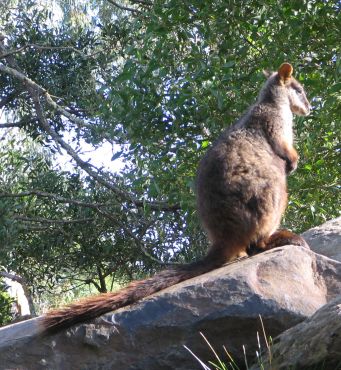
Summary of actions 2014
A review of the conservation objectives for the Brush-tailed Rock-wallaby, including reintroductions has been completed. The Flora and Fauna Guarantee Action Statement has also been revised to a draft and reflects management information gained in recent years. Outcomes from the review and the revised Action Statement will form the basis for on-going recovery efforts, focusing on captive breeding whilst maintaining the security of wild populations through predator control and population monitoring.
Important partners in the captive breeding program are Mount Rothwell Biodiversity Interpretation Centre and Tidbinbilla Nature Reserve.
Grampians National Park
A small population of Brush-tailed Rock-wallabies still remains in the Grampians. This population is regularly monitored with remote cameras and tracking devices. On-going predator control is maintained to a high level to reduce predation from foxes.
East Gippsland
There are four key sites in the Snowy River National Park comprising a total wild population of approximately 30 Brush-tailed Rock-wallabies. The four genetically distinct populations are monitored and appear to be holding their own with the assistance of a fortnightly predator control program in place. No reintroductions are planned in the foreseeable future.
Summary of actions 2016
Release of the Southern Brush-tailed Rock Wallaby at Mt Rothwell for open range captive breeding program. Clip produced by DELWP
Summary 2017
Images taken with remote cameras used by Parks Victoria rangers at the Grampians to monitor Brush-tailed Rock-wallabies during late January & February 2017. This is the first footage of a joey out of the pouch at the Grampians, taking its first hops in life.
2025
Grampians bushfire recovery
The Grampians bushfires which started on 17 December 2024 and continued to burn into January 2025 has impacted the Brush-tailed Rock-wallaby population in the area. Impacts are on direct mortality due to the fire, displacement and loss of habitat in terms of cover and food source.
Parks Victoria and Forest Fire Management (DEECA) have carried out emergency food supplement drops by air to the remaining Brush-tailed Rock Wallaby population in the burnt area commencing on 31 December, Pleasingly, 4 Brush-tailed Rock-wallabies were observed during the first feeding operation.
Parks Victoria will continue to monitor the population and undertake further feeding.
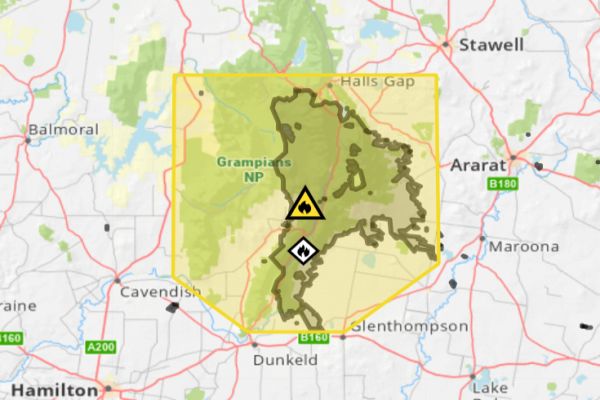
References & Links
- DEC (2005) Draft Recovery Plan for the Brush-tailed Rock-wallaby Petrogale Penicillata, NSW Department of Environment and Conservation (NSW), (2005), DEC: Sydney.
- Delaney, R., Temple-Smith, P., McLean, N. (2004) Translocation Strategy for the Brush-tailed Rock-wallaby in Victoria – Final Report, EnviroSense Consulting for the Victorian Brush-tailed Rock-wallaby Recovery Team, Department of Sustainability & Environment and Parks Victoria.
- DEECA (2023) Flora and Fauna Guarantee Action Statement Taxon ID: 11215, Brush-tailed Rock-wallaby, Department of Energy, Environment and Climate Action, Victoria, 2023 -Brush-tailed Rock-wallaby FFG Action Statement pdf
- Eldridge, M. D. B., Kinnear, J. E., Onus, L. (2001) Source population of dispersing rock-wallabies Petrogale lateralis idengified by assignment tests on multilocus genotypic data, Molecular Ecology Volume 10, Issue 12, Page 2867 - December 2001.
- FFG Threatened List (2024) Flora and Fauna Guarantee Threatened List, Department of Energy, Environment and Climate Action (DEECA), June 2024.
- Lobert, B., & Waters, R. (1988) The Brush-tailed Rock-wallaby Petrogale penicillata in the Grampians National Park and the Black Range, Victoria, Part 1 Survey, Australian Biological Research Group Pty. Ltd, Technical Report Series No.64, Arthur Rylah Institute for Environmental Research.
- Lunney, D., Law, B., Rummery, C. (1997) An ecological interpretation of the historical decline of the Brush-tailed Rock-wallaby Petrogale Penicillata in New South Wales, Australian mammalogy, vol.19 (2), 281-296, 1997.
- Maynes, G. M., Sharman, G. B. (1983) Brush-tailed Rock-wallaby Petrogale penicillata, In: Complete book of Australian mammals, Ed. Strahan, R., Angus & Robertson Publishers.
- Maxwell, S., Burbidge, A. A., Morris, K. (1996) Action Plan for Australian Marsupials and Monotremes for the Australasian Marsupial and Monotreme Specialist Group, IUCN Species Survival Commission Published December 1996.DEWHA Action Plan for Australian Marsupials and Monotremes 1996
- Menkhorst, P. (1995) Brush-tailed Rock-wallaby, In: Mammals of Victoria, Ed. Menkhorst, P. W., Oxford University Press, Australia.
- Piggott, M. P., Banks, S. C., Stone, N., Banffy, C., Taylor, A. C. (2006) Estimating population size of endangered brush-tailed rock-wallaby Petrogale penicillatacolonies using faecal DNA, Molecular Ecology vol. 15, Issue 1, 2006
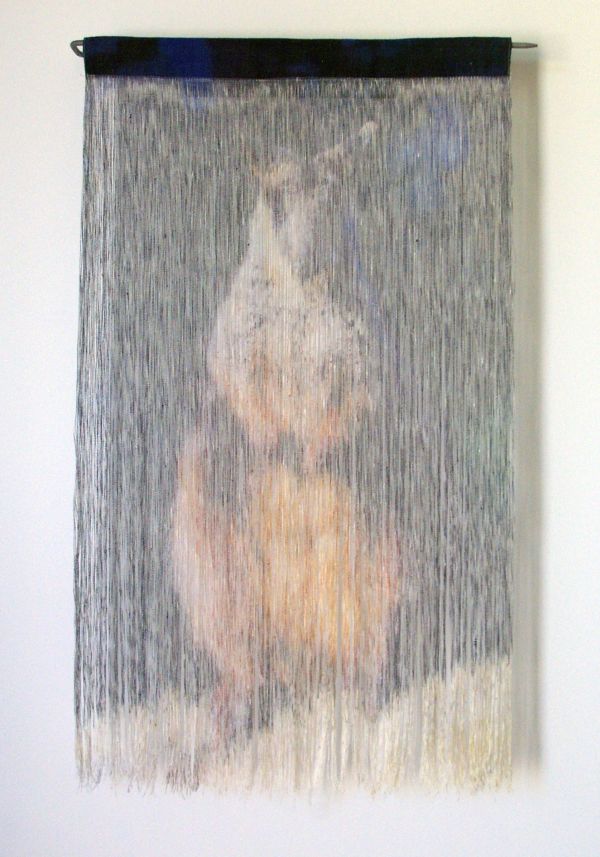
Water-based, non-toxic, solvent free pigment ink on linen fabric, linen thread, stainless steel. 113 x 80 x 8.5 cm. By Jane Burns
This art work depicts the precarious state of the Brush-tailed Rock-wallaby. Will this critically endangered species continue to disappear?
More Information
- Brush-tailed Rock-wallaby Victorian web site
- New South Wales Department of Environment, Climate Change Brush-tailed Rock-wallaby Recovery Plan 2008 (1.1MB PDF)
- Home-range studies in a reintroduced brush-tailed rock-wallaby (Petrogale penicillata) population in the Grampians National Park, Victoria CSIRO Publishing; Australian Mammalogy 33(2) 128-134)
Please contribute information regarding Brush-tailed Rock-wallaby in Victoria - observations, images or projects. Contact SWIFFT

